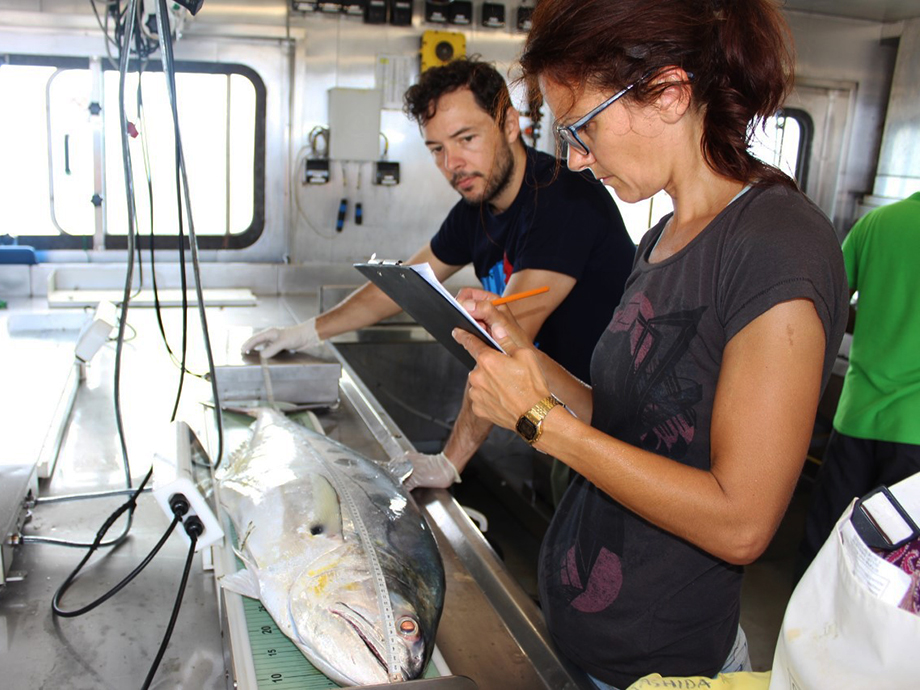Fish: The “perfect micronutrient” in ensuring global food security and nutrition. Case studies of the Nansen research surveys in Angola, Bangladesh and Sri Lanka.
Fish plays a critical role in achieving food security and good nutrition. It's rich in protein and contains many essential micronutrients – vitamines A, B12, D - and minerals (i.e. calcium, zinc, iodine, iron). According to recently published FAO's landmark 2020 State of World Fisheries and Aquaculture (SOFIA) report, around 88% (156 million tonnes) of world fish production was destined for direct human consumption in 2018, a significant increase from 67% in the 1960s. A growing demand for fish clearly demonstrates that instead of being used as animal feed, fish can feed the world, when converted into high quality food.
 |
 |
|
Sample of different fish species caught during the 2018 research survey in Bangladesh waters. |
Sorting fish catch during the 2018 research survey in Bangladesh waters |
Its unique nutritional value brings about health benefits for billions of people in low- and middle-income countries, protecting at the same time against various diseases. Throughout fisheries-related activities, fish is also a source of income for millions of low-income families and contributes directly and indirectly to food security of more than 10% of the world population, primarily in developing parts of the world. Yet still today, potential contributions of fish to food security and nutrition are neglected in international debates, in areas where it actually could yield the largest benefits – reducing hunger and mulnutrition, as well as supporting livelihoods.
The three latest scientific publications by the "Nutrition and Food Safety" team of the EAF-Nansen Programme's Science Plan account for the first comprehensive analysis of nutrient composition of commonly-consumed marine fish in Angola, Bangladesh and Sri Lanka, where existing data are scarce. The newly-aquired knowledge has therefore a great potential to contribute significantly to the future food composition database, which remains a challenge in many regions of the world, due to lack of necessary equipment for analysis. In all the above-mentioned cases, sampling of marine fish species (demersal, pelagic and mesopelagic) was carried out as part of research surveys in 2017 and 2018 on board the vessel Dr Fridtjof Nansen, with access to laboratory facilities and due expertise.Fish species were selected for nutritional study, based on their importance to local food habits, as advised by the fisheries institutions in the EAF-Nansen Programme's partner countries. Analyses of micronutrients, vitamins, minerals and chemical contaminants, coming from the same samples, were performed at the Institute of Marine Research in Norway, in order to ensure a harmonized approach between countries, in line with international standards.
 |
 |
|
Sorting fish catch during the 2018 in the Bangladesh Coast |
Recording of fish data, conducted as part of the 2018 research survey in Bangladesh waters |
Improving knowledge on the nutritional value of fish, and on possible presence of contaminants (including microplastics), is an integral component of the Science Plan in the current phase of the EAF-Nansen Programme (2017-2021), which a long-term objective is that „sustainable fisheries improve food and nutrition security for people in parter countries." Additionally, knowledge sharing, by bringing experts together in workshops on nutrition and food safety, contributes to developing and strenghtening regional capacity among the Programme's beneficiary countries, together with supporting their efforts towards realising the UN's Sustainable Development Goals (SDGs), in particular SDG1, SDG2, SDG5, and SDG14, by 2030 deadline.
Some of the key takeaways from the three case studies point that:
- Fish is a rich source of several important micronutrients, yet its benefits are still underestimated. Even today, staple foods (such as cereals) are used as a way of suplementation and fortification instead of fish, even though fish is more nutritious and therefore should be implemented in food-based systems.
- The results coming from the publications clearly demonstrate that for example, mesopelagic fish can represent an important source of marine nutrients. However, present knowledge and research on these species are particularly sparce.
- Small fish species are significantly more nutrient dense than larger species, where only the fillet is consumed.
- All species analysed can be of important dietary sources of protein, micro-nutrients and fatty acids, if included in the diet.
|
|
The results gained by the analysis of the samples from Angola, Bangladesh and Sri Lanka, using high-quality analytical methods, prove that fish is a unique, "perfect micronutrient". For example, fish and fish products in Sri Lanka comprise approx. 55% of total animal intake per capita and are therefore considered as the most important source of animal protein in the country's diet. In order to reach UN's SDG2 ("Zero Hunger"), improving food-based strategies and exposing the value of nutrition is imperative. In addition, the data show that even small amounts of fish consumed whole can contribute significantly to micronutrient intakes. Fish is therefore an excellent source to be used in food-based approaches to reduce "hidden hunger" in developing regions of the world.
"The Nutrition and Food Safety" team continue analysing data on nutrients and contaminants (including microplastics and parasites) from the remaining cruises (for example from East Africa), and evaluating factors that can explain variation between and within species (e.g. season, area, size). The outcomes will be published soon. Capacity-building is an ongoing aspect of the EAF-Nansen Programme's work, and strenghtening the role of regional collaboration remains one of the top priorities.
Access and download publications:
- Nutrient and Chemical Contaminant Levels in Five Marine Fish Species from Angola
- Nutrient Composition of Demersal, Pelagic, and Mesopelagic Fish Species Sampled Off the Coast of Bangladesh and their Potential Contribution to Food and Nutrition Security
- Nutrient Composition of 19 Fish Species from Sri Lanka and Potential Contribution to Food and Nutrition Security
For more information:

